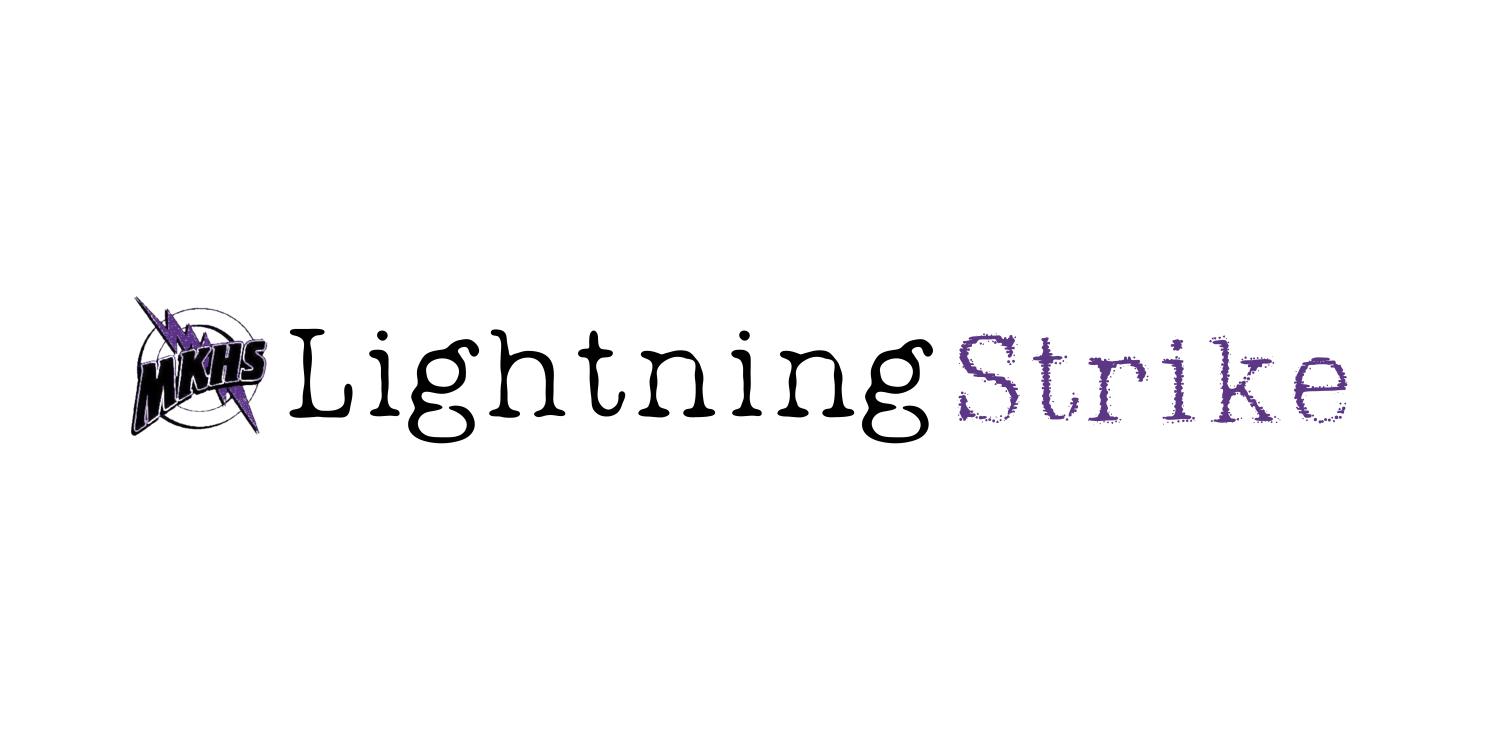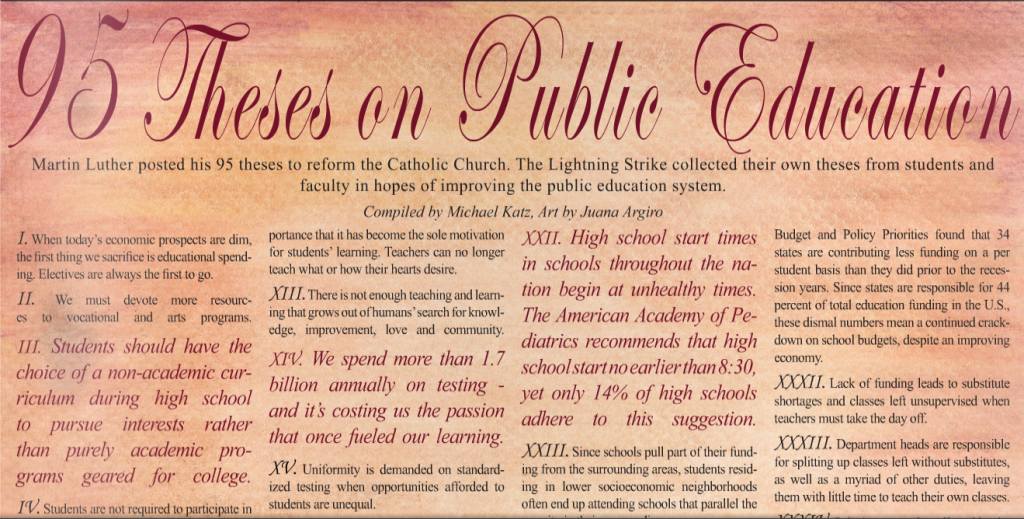You cannot fix something until you know what is wrong with it – which is why The Lightning Strike asked students and faculty to share with us the most grievous problems in education today. Here is our 95 Thesis on the public education system of the United States of America.
1. When today’s economic prospects are dim, the first thing we sacrifice is educational spending. Electives are always the first to go.
2. We must devote more resources to vocational and arts programs.
3. Students should have the choice to choose a non-academic curriculum during high school to pursue interests rather than purely academic programs geared for college.
4. Students are not required to participate in clubs or afterschool activities. If a student has no initiative or self-motivation, they will simply drift through the school system until it’s too late, simply because nothing more was expected of them.
5. Competition created by a lack of educational resources puts students in a mindset of competing, not cooperating.
6. In Florida, every course taken by a student online equates to $800 of funding their school doesn’t receive.
7. At $8,433 per student, Florida ranks 41st in per-student funding. Our students are our future – and it seems like we’re not investing too wisely.
8. Students are no more than I.D. numbers, and our test performance has become a direct measure of our intelligence.
9. Curricula have dominated the school system. Teachers have less and less of a say in what or how they teach, and labs like hatching chicks or keeping class pets are beginning to sound more like myths than part of a student’s childhood.
10. The quality of our education is based on the way it looks on paper. Everything we learn has been reduced to a benchmark, everything we do placed on the ticking timeline of our curricula.
11. Not all students want to become lawyers or doctors, and cutting non-academic electives during tough times keeps students from discovering or developing their passions.
12. Test scores have been given so much importance that it has become the sole motivation for students’ learning. Teachers can no longer teach what or how their hearts desire.
13. There is not enough teaching and learning that grows out of humans’ search for knowledge, improvement, love and community.
14. We spend more than 1.7 billion annually on testing – and it’s costing us the passion that once fueled our learning.
15. Uniformity is demanded on standardized testing when opportunities afforded to students are unequal.
16. Financial incentives are put in place to motivate teachers to get their students to perform well on standardized tests, making it even harder for them to resist teaching to a test.
17. Testing starts as early as February and lasts until the end of the school, meaning that almost every day during the second half of the school year, students miss valuable class time to take some form of a standardized test.
18. Oftentimes teachers are pulled from their classes to proctor standardized testing, leaving teachers unable to teach and students unable to learn.
19. The legislators making decisions about our education work in offices all day – school board members are not required to visit schools under their jurisdiction, and their isolation results in schools being run like machines.
20. Education falls short when it comes to preparing students for real life – we graduate able to calculate the hypotenuse of a triangle yet clueless as to how to buy a house or invest our money wisely.
21. Separating students into categories such as regular, honors, gifted, and AP causes students to resent each other because some feel inferior to others, and often those not in advanced courses don’t receive the same push that is needed to succeed as those who are.
22. High school start times in schools throughout the nation begin at unhealthy times. The American Academy of Pediatrics recommends that high school start no earlier than 8:30, yet only 14% of high schools adhere to this suggestion.
23. Since schools pull part of their funding from the surrounding areas, students residing in lower socioeconomic neighborhoods often end up attending schools that parallel the scarcity in their surroundings.
24. Students in some schools take six classes a year while others take eight – in the same amount of time. As a result, some students have a much greater advantage when applying to college.
25. Grades are a poor reflection of a student’s capacity and potential, yet students are taught to think that grades define them because they are given such importance.
26. The structure of the system suffocates creativity. Since we enter kindergarten, we are taught to follow rules, obey our teachers, not speak unless we are called on – we can’t even go to the bathroom unless we ask. When we spend so much time thinking and acting in accordance with the rules, it makes thinking out of the box more challenging than it already is.
27. The pressure put on students to perform well on tests leads to cheating, both by students and teachers. Either we cheat, or we’re cheated by a system that lets our grades dictate our opportunities – there’s no way out of it.
28. Studies show that crowded classrooms hamper students’ abilities to learn, yet over 22 percent of schools nationwide are overcrowded.
29. Crowded classrooms interfere with high quality interactions, feedback, and relationship building.
30. AP and Honors classes aren’t regulated by the Class Size Amendment – a law that caps classrooms at 25 students.
31. A recent report from the Center on Budget and Policy Priorities found that 34 states are contributing less funding on a per student basis than they did prior to the recession years. Since states are responsible for 44 percent of total education funding in the U.S., these dismal numbers mean a continued crackdown on school budgets, despite an improving economy.
32. Lack of funding leads to substitute shortages and classes left unsupervised when teachers must take the day off.
33. Department heads are responsible for splitting up classes left without substitutes, as well as a myriad of other duties, leaving them with little time to teach their own classes.
34. Substitutes are also affected by the lack of funding. Many states have banned substitutes’ unions, leaving them to the mercy of the state legislators.
35. In Florida, substitutes are unable to work for more than 10 days consecutively, because if they would, schools would have to give them benefits such as health insurance.
36. Many students who were deemed ready to join the workforce and/or enter college by the public school system end up dropping out of college and entering menial jobs due to a lack of preparation.
37. Politicians dictate curriculum, funding, and in Miami Dade County, they have limited the amount of time attendees of school board meetings could speak.
38. Students, parents and teachers need to have a bigger voice in deciding the education afforded to them, because no one knows what they need better than them.
39. More parents need to be involved in the education system – and not just to fundraise. Parents need to teach what teachers don’t have the time – or the energy – to: ethics.
40. Most of today’s schools teach to auditory learners – students who can sit down quietly, listen to a lecture without asking any questions or interacting with their peers – when very few students in fact are able to learn that way.
41. Education is not a priority for our nation. Those running for government positions focus their campaigns and their legislation on issues such as unemployment and terrorism, and since most students can’t vote, their voices go unheard until unemployment is their main concern.
42. Lack of funding forces some teacher to offer extra credit for bringing in supplies, leading to students buying their grades. Those that have parents that can go buy pencils or copy paper benefit, while those who have to get pencils from the floor are left at a disadvantage.
43. In several states, laws regulating teachers’ pensions are unjust. In New York, for example, teachers who work 24 years get a substantially smaller pension than those who work 25 years. As a result, less than .1 percent of teachers retire after 15 years, and remain teaching until their pension fully vests, despite the fact that they’re burned out.
44. Studies have shown that the minutes allotted to the traditional practice of recess has shrunk in 40 percent of school districts around the country, and some newly built elementary schools don’t even have playgrounds.
45. Our one-size-fits-all standardized testing system leaves the plethora of students that hard a hard time taking tests, like those with ADHD, at a loss because their performance on such tests determines the opportunities they’ll have open to them after they graduate high school.
46. The people deciding which courses qualify as academic electives or fine arts credits aren’t the ones sitting in the classrooms – students could be working harder in a “non-academic” elective than they do in any core class, without receiving the same credit.
47. Bullying has been and will always be a part of schools – yet less and less schools have the money to keep a full-time psychologist on the payroll, and as a result, less and less students are receiving the support they need to deal with it properly.
48. People are rooted in their belief that a traditional classroom setting is the best way to teach students. If less money was spent on textbooks and more was spent on developing new, interactive, specialized teaching methods perhaps students would be more excited about leaning.
49. Most questions about why funding is continually cut or why students are forced to take certain courses are answered with a simple, “I don’t know. The people downtown make those decisions.” Yet no one knows who the people in Tallahassee even are.
50. It is the responsibility of the school system to educate and create able, outgoing students – a responsibility which it has been failing to fulfill recently. Public schools should be solving problems, not contributing to them.
51. The National Assessment of Educational Progress (NAEP), the largest standardized test administered in the United States, reports that fewer than 40 percent of graduating seniors have mastered reading and math and are poorly equipped for college and real world life.
52. Teachers are forced to retire the month after their birthdays, leaving students teacher-less mid-year in the cases where their extensions are not approved.
53. Obstacles like feckless politicians, recalcitrant unions and mediocre teachers keep even those willing to change the system from doing so.
54. Kids are being pushed into advanced courses at earlier ages each year – pressuring them to adapt and perform at much higher levels as early as elementary school.
55. Public school are pouring funding down the drain on textbooks. California spends an average of $400 million on textbooks each year, Texas $500 million, and Florida $260 million. Of course we need textbooks, but do we really need new ones each year? Not much changes in US History or Algebra in 12 months.
56. Those with any power are so isolated from the actual schools themselves that students don’t even know who to voice their concerns to.
57. Most teachers are not required to specialize in the field they plan on teaching in, but are instead allowed to get a masters in education itself.
58. The public education system needs to put a larger emphasis on accountability and accessibility of those in charge.
59. End-of-year tests like Common Core test short-term memory; since students are taught to pass the test and not for the love of learning, they retain the information until they finish the test – after which they promptly forget it all.
60. More schools need to offer interactive learning environments to students in order to engage and reach more of them.
61. Every year, more students are pushed to take more advanced academic courses, which overshadow electives that once helped students explore possible career options. They aren’t forced to do so, but the pressure put on them by colleges, peers, and administrators makes them feel like they are.
62. As schools are forced to keep up with ever-increasing standards, recess is becoming more of a myth than a reality for students.
63. More attention is devoted to reprimanding students than is devoted to listening to them. Maybe if students were more engaged and able to shape their learning environments, disruptive behavior would decrease.
64. Once students choose a certain track (AP, Honors, etc.) they often feel pressured, both by their peers and their administrators, to remain on that course, leaving students both unwillingly and unhappily participating in a track that they feel is their only choice.
65. Colleges continue to raise their admission requirements and schools continue to raise their standards to meet colleges’ demands, leaving students stressed, anxious and even depressed because they feel the need to be constantly studying if they wish to succeed.
66. Little to no value is given to teachers – the backbone of our educational system.
67. In the days of yore, students made the score. We don’t need our hands tied by common core!
68. The U.S. has an average high school graduation rate of 80 percent. With over four million seniors annually, that’s 800,000 seniors that are left without a diploma.
69. Teachers aren’t rewarded for going the extra mile for their students – extra hours go unpaid and unique, entertaining lesson plans go unseen, so teachers have no reason to do more than the minimum.
70. Teachers aren’t paid for the work they do outside of school, whether it’s grading papers, staying after school to assist students, yet there is no way they could grade all of their papers well during school – planning period or not.
71. The education “now a days” most definitely does not cover what students need to know before they enter college. Maybe we should start listening to our students and stop teaching to a test. As our seniors put it, we need to “hire some nice teachers” and let them do their job.
72. We must stop trying to fix the education system from the top down. Stock schools with well-trained teachers, enough security and custodians, and watch students and teachers thrive rather than strive.
73. Students now have the option of taking P.E. online, and since only one year of the class is required, the number of students taking it in school has been rapidly decreasing each year. Students should not have the option to take P.E. online, and should be required to take the class during all four years of high school.
74. Because they are undervalued, schools are no longer attracting caring, enthusiastic teachers, and are left hiring unwilling and apathetic teachers and then trust them with providing the next generation with a proper education.
75. Teachers are limited in the comments they they can give to a student in their report card. If they truly want to relay a comment or concern to a student or their parents, they have to request a conference – which oftentimes parents are unable to attend.
76. Teachers’ lack of freedom can leave even the good teachers – the ones that love to teach – dismayed and apathetic.
77. In order to attract teachers who love the subjects they teach and are able to instill that love in their students, teachers must specialize in the fields they plan to work in.
78. Fitness and healthy living is no longer considered an essential part of a complete public education. Students aren’t normally affected by non-genetic health problems until later on, but if they were taught how to eat and exercise then disease would no longer be such a problem in this country.
Don’t believe it? Check out the next fifteen theses, written by juniors and seniors of the 2016 class and published verbatim:
79. “The county should hire teachers that can teach and should also hire nice teachers.”
80. “teache’s are never here But education feel like nothing cause we dont even learn anything haffe of the time. it’s not like Back in the day’s when learning was fun But Now is Boring, hard, or we dont even learn it,”
81. “In my opion the most wrong thing that the school’s in the U.S. don’t imply is the use of forienge language’s so that student can learn more than two language.
82. “I think what is wrong with our education is that we barely learn anything anymore because most of the times our teachers are not here to teach us what we need to know.”
83. “Another issue is how the teacher’s who don’t teach and just give out paper work and packets.”
84. “The thing that needs to be improv is less test taking. Also what needs to be improved is the quality of what the teacher teaches.”
85. “One of the biggest challenges we have today is education let me explain why teacher’s are never here or if they are here they are in meeting, were have they gone teaches!!”
86. “Testing is hold back a lot of students from passing. If the student have an “A” in the class just be failing the test could drop there grade low.”
87. “What is failing me as a student is that most times you are forced to choose between your mental health and your G.P.A. In example, most nights we have episodes of anxiety or depression, you are pressured to choose wether to feel better and get a good night sleep or study for the test.”
88. “Education today is getting worse. The education now a days don’t cover the important things that the students need when they get to college.”
89. “Teacher are not teaching enough or just not teaching at all because students like us are not learning enough.”
90. “engage projectbased learning connect intergated students share cooperative assessment”
91. “Teacher only teach what is in the state test!”
92. “To me as a student that is failing me the most is testing, such as math, reading and so on. I beileve it would be better to take those away.”
93. “Tests are holding seniors back from their future, its like they putting a hold on our life to pass a test that’s not really important.”
94. Not everything should be blamed on the system, however. There is and has been a decrease in students with determination and strive – in the number of students that take responsibility for their education because they want to succeed.
95. The only question that remains is this: why is the American Dream fading away? What is making our students feel like cheating their way through their educations will lead them to success? Why aren’t our students excited about learning? And that’s something we must all think about.































Steve mccrea • Feb 8, 2019 at 10:37 pm
Look at the Daniel Willingham book “Why students don’t like school?”…. he addresses several of these theses. Good idea to make a list. See the innovative procedures that address some of these items … suggested by pioneers like Dennis Littky. Neil Postman, Abraham Fischler, tinyurl.com/littkyradio for an interview with littky on national public radio in April 2005
Tinyurl.com/cpppsite for specifics….
Tinyurl.com/cpppprocedures for 15 procedures that some innovative teachers recommend.